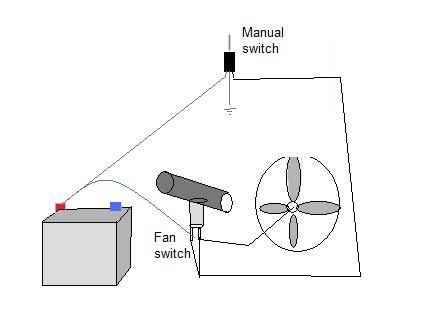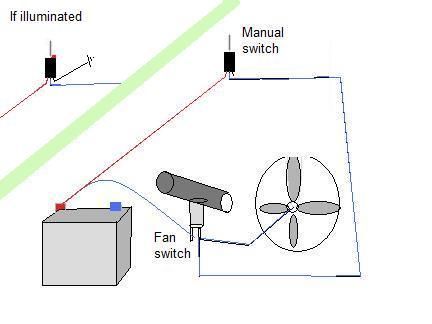Page 1 of 3
wiring manual fan switch
Posted: Sat Oct 05, 2013 3:19 pm
by romus
I have just wired up a manual fan switch, But I am a bit worried about my + wire direct from the battery. Has anyone spliced into the run switch or ignition switch wires? If so how? My guess is I could strip a piece of wire bare near the front connector (e.g., the run switch YG) and solder and shrink wrap it). Just wondering if anyone else has done something like this?
The reason I am worried about the direct wire from the battery is because it means:
a) someone could come along and flick the fan switch while I was away from the bike and leave it running. No key needed!
b) There are a lot of wires in the front area, so if there was some kind of short sparking starting with smoke from that manual fan switch wiring, turning off the ignition or the run switch would not stop the problem - could even be the cause of some fires that have happened to others.
Re: wiring manual fan switch
Posted: Sun Oct 06, 2013 11:46 am
by 907pasonut
it wouldn't be too difficult to find a +ve wire that has power only when the ignition switch has been switched on, it would only take 5min with a multimeter...I'm not familiar with a 906 but you should have those large 'jones plugs' near the steering head, check through the top of plug (with volt meter) to find a +ve that is only on with ignition, and do a piggy-back connection.
the other benefit is this connection would most likely be after a fuse, the fan motor doesn't draw too much anyway
Re: wiring manual fan switch
Posted: Sun Oct 06, 2013 11:58 am
by higgy
Why not just tap into the fan switch ? That way you can retain the cooling fan switch function just have the option to turn it on yourself
Re: wiring manual fan switch
Posted: Mon Oct 07, 2013 2:18 am
by romus
higgy wrote:Why not just tap into the fan switch ? That way you can retain the cooling fan switch function just have the option to turn it on yourself
I tapped into the blue wire that goes from the fan switch to the fan - which should still retain the cooling fan, aye?
There was a spare output tab from a relay that I have for the coil relay, so I have used that - so, good now the ignition has to be on for the fan switch to work :-)
Re: wiring manual fan switch
Posted: Mon Oct 07, 2013 10:40 am
by higgy
no you need to have it setup to bypass the switch
Re: wiring manual fan switch
Posted: Mon Oct 07, 2013 11:15 am
by romus
higgy wrote:no you need to have it setup to bypass the switch
How would I do that, Higgy?
Re: wiring manual fan switch
Posted: Mon Oct 07, 2013 10:44 pm
by higgy
First do you have a one wire or two wire fan switch ? Its on the manifold above the fan.
If one wire just pig tail it to a ground, don't put it inline
If 2 wire pig tail between the two wires
Re: wiring manual fan switch
Posted: Tue Oct 08, 2013 5:08 am
by Mc tool
Why do you want a manual fan switch , unless of course its to keep the flies away while your parked up having a beer

Re: wiring manual fan switch
Posted: Thu Oct 10, 2013 12:58 pm
by romus
higgy wrote:First do you have a one wire or two wire fan switch ? Its on the manifold above the fan.
If one wire just pig tail it to a ground, don't put it inline
If 2 wire pig tail between the two wires
I have a two wire fan switch. Like this?
OOps that was wrong, so I have taken the pic off

Re: wiring manual fan switch
Posted: Thu Oct 10, 2013 1:20 pm
by romus
Mc tool wrote:Why do you want a manual fan switch , unless of course its to keep the flies away while your parked up having a beer

I think it is because in hot weather and eg in a traffic jam the bike overheats even with the fan - especially when the radiator is a bit old. So if you switch the fan on a bit earlier then (because its working from a cooler start, it keeps the temp under control. Same as if the thermostat opened at a lower temp.
Re: wiring manual fan switch
Posted: Thu Oct 10, 2013 2:02 pm
by paso750
I have a two wire fan switch. Like this?

No. Use a manual on/off switch with two contacts (and there`s no need for a ground connection on the switch unless it`s illuminated. If you`d toggle the switch on your drawing to the right you`d connect the battery + to ground!). Then connect the output of the switch to the wire that goes from the original switch to the fan (hence to the right contact on your picture)
If you have manual switch with three contacts just use two and let one of the outer ones unused (again if it´s not an illuminated switch which I`m assuming it`s not).
G.
Re: wiring manual fan switch
Posted: Thu Oct 10, 2013 2:48 pm
by romus
G,
Like this? Actually, I do have an illuminated switch.

Re: wiring manual fan switch
Posted: Thu Oct 10, 2013 3:02 pm
by paso750
yes, that`s it. If you toggle the switch to the left the circuit is open and if you switch it to the right you`re bypassing the original switch and the fan will run.
Your switch may have some printing on it like this one:

Re: wiring manual fan switch
Posted: Fri Oct 11, 2013 8:04 pm
by Mc tool
Ah ... Im not sure I understand the logic there Warick ( faark man , how diplomatic was that !

) Mine gets hot in traffic too and eventually , if nothing is moving , I have to switch it off as it starts spewing out water . however I always put that down to the fact that my resivor cap is rooted and doesn't seal at all ( its only there to keep the coolant in when I get airborne ) and Im pretty sure the radiator is clear ( flushed it with the weed sprayer pump on the back of the tractor ) , having said all that it has only happened twice in 7 years so ( knowin me ) I aint likely to panic

Re: wiring manual fan switch
Posted: Fri Oct 11, 2013 11:06 pm
by higgy
if the bike is overheating replace the fan switch and check the radiator and thermistat.
putting a switch in one side or the other of the fan switch circuit will not turn the fan on, it will just keep the fan switch from working. you have two choices, wire the power supply to one side of the switch and the other to a ground or pigtail from both wires through the switch, in effect replacing the fan switch but allowing the fan switch to still operate normally


